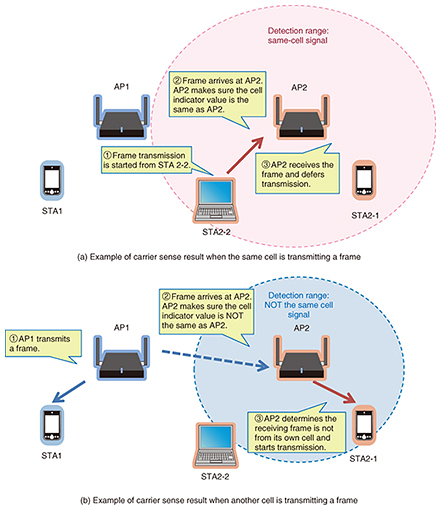1. Introduction
Standards for wireless local area networks (LANs) are developed by the Institute of Electrical and Electronics Engineers (IEEE) 802.11 Working Group (IEEE 802.11 WG) of the IEEE 802 LAN/MAN (Mobile Area Network) Standards Committee. The recently published standard IEEE 802.11ac [1] enables very high throughput greater than 1 Gbit/s. Wireless LAN interfaces are being implemented in more and more products such as personal computers and mobile terminals such as smartphones, resulting in rapid growth of the market for Wi-Fi-enabled terminals, with over 12 billion cumulative shipments in 2015 [2].
However, new problems have emerged with the proliferation of wireless LAN terminals. One problem is degradation of transmission efficiency, which occurs when many wireless LAN terminals interfere with each other. The reason for this is that wireless LAN devices acquire channel access opportunities in accordance with the Carrier Sense Multiple Access with Collision Avoidance (CSMA/CA) protocol, which avoids simultaneous transmission on the same frequency resource. This means that the transmission opportunities of each terminal decrease in dense deployment scenarios.
Major Wi-Fi vendors and communication carriers including the NTT Group are working to overcome this and other challenges, and they have held discussions on the next-generation wireless LAN standard, which is intended to achieve high transmission efficiency even in dense wireless LAN environments. The IEEE 802.11 WG established a new task group that will work on the standardization of the next-generation wireless LAN 802.11ax standard in order to improve wireless LAN performance in dense environments [3, 4].
2. Scope of IEEE 802.11ax
Several technical requirements for the new wireless LAN standard were discussed before the creation of the Task Group ax (TGax) in the IEEE 802.11 WG. The conclusions of these discussions were summarized in a Project Authorization Request (PAR) [5] and in Criteria for Standards Development, which state the goal and the necessity of this standardization. The key points in the PAR are below, which states that the standard should:
- Modify both the IEEE 802.11 physical layers (PHY) and the IEEE 802.11 medium access control layer (MAC)
- Enable at least one mode of operation capable of supporting at least four times improvement in the average throughput per station (terminal) measured at the MAC data service access point (SAP)*1 in dense deployment scenarios
- Maintain or improve the power efficiency per station
- Operate in frequency bands between 1 GHz and 6 GHz indoors and outdoors
- Enable backward compatibility and coexistence with legacy IEEE 802.11 devices operating in the same band
The primary objective of the 802.11ax standard is to achieve high efficiency in dense deployment scenarios. This differs from the main objective of 802.11ac, which is to increase the maximum MAC-SAP throughput. Consequently, the goal is not to achieve maximum throughput but to improve the average throughput per station.
IEEE 802.11ax is expected to significantly improve the communication quality and user experience in very populated areas such as train stations, airports, and stadiums. Furthermore, high transmission efficiency in dense deployment scenarios will result in an increase in the number of wireless LAN service users.
3. Techniques under consideration
in 802.11 TGax
TGax is currently considering the use of various techniques in 802.11ax to improve spectrum efficiency:
- A signal format with high tolerance to delayed waves
- Multi-user transmission
- Spatial reuse of frequency resources
These are explained in the following subsections.
3.1 Signal format
In IEEE 802.11ax, the outdoor environment is viewed as an important scenario that has not been examined in detail. The main issue with the outdoor environment is a large delay spread of the radio signal. The delay spread tends to be larger in outdoor environments than in indoor environments, which causes serious degradation at the receiver. Therefore, in 802.11ax, the orthogonal frequency division multiplex (OFDM) symbol length will be extended by four times to combat the long delay spread in outdoor environments (Fig. 1). The expansion of the symbol length will also relax the timing requirement of uplink multi-user transmission. Moreover, it is expected to be more flexible when resources are allocated for OFDMA (OFDM access) transmission because the number of subcarriers*2 increases if the symbol length becomes longer.

Fig. 1. �Four times longer OFDM symbol.
3.2 Multi-user transmission
Multi-user transmission enables an access point (AP) to communicate with more than one client simultaneously. In the 802.11ac standard, downlink multi-user multiple input multiple output (MIMO) was introduced. The multi-user MIMO applies spatial multiplexing for transmission to more than one destination with one antenna or multiple antennas; in other words, it achieves higher spatial multiplexing gain and improves communication efficiency compared to single-user MIMO.
Further expansion of multiplexing and uplink/downlink directions are under consideration in discussions on the 802.11ax standard. To be more precise, (1) downlink OFDMA, (2) uplink OFDMA, and (3) uplink multi-user MIMO are under discussion. The downlink OFDMA has already been introduced in WiMAX (Worldwide Interoperability for Microwave Access) and LTE (Long Term Evolution), which use frequency multiplexing. The implementation to a module is easier than in multi-user MIMO, so it is expected to be used in more APs. In addition, several patterns of resource allocation have been proposed that will result in more efficient use of frequency resources, as depicted in Fig. 2. The uplink OFDMA and the uplink multi-user MIMO apply the multi-user transmission technique in the uplink direction. It is regarded as an effective technique to enhance the uplink transmission efficiency, particularly when there is a transmission acknowledgment for a multi-user downlink (Fig. 3). In order to achieve simultaneous transmissions from more than one station, a new control frame called a trigger frame has been discussed for timing synchronization in multi-user uplink transmissions.

Fig. 2. �Example of allocation of frequency resource block at 20 MHz.

Fig. 3. �Comparison of overhead needed for acknowledgment from more than one station.
3.3 Spatial reuse
In dense deployment scenarios, there will be several wireless LAN service areas on the same
frequency channel. In such cases, frequency resources are shared by those areas following the CSMA/CA protocol. To improve the spectrum efficiency of the service areas, control of the Clear Channel Assessment (CCA) threshold has been discussed as a way to enable frequency re-use at closer distances. The CCA threshold is used to determine the channel status—that is, whether it is IDLE or BUSY.
In the early days of wireless LAN, the density of wireless LAN terminals was not very high, and the CSMA/CA protocol with the existing CCA threshold worked very well. However, with the increasing popularity of wireless LANs, throughput degradation in dense environments has become much more serious due to inadequate transmission opportunities. In the 802.11ax standardization, controlling the CCA threshold is being considered as a solution for this problem. This technique makes it possible to set the CCA threshold higher than the conventional one when the channel has sufficient quality, which enables a new transmission to be started on top of an on-going transmission to improve the spatial spectral efficiency.
Of course, this technique is only possible when the existing transmission is happening in another wireless LAN area. If a wireless LAN terminal begins to transmit frames when another frame from the same cell is being transmitted, a packet collision would occur, and the transmission would not be received at the desired destination. Therefore, a method is needed to determine whether the receiving frame is from its own area or from another area, and thus, the use of an indicator in a PHY header is being discussed. When the receiving frame is determined to be from another area, the wireless LAN terminal will set the CCA threshold higher (Fig. 4), and channel contention will become more aggressive. Other conditions and the method of controlling the transmission power, which enables the CCA threshold to be controlled, are also under discussion. These promising techniques are expected to be useful to expand the system capacity.

Fig. 4. �Carrier sense based on the cell indicator.
| *1 |
MAC data SAP: Interface between MAC layer and upper layer. |
| *2 |
Subcarrier: Carrier wave multiplexed with OFDM. |
4. Schedule of standardization
As of September 2016, technical discussions were continuing toward achieving draft version 1.0, scheduled for release in November 2016. Many companies including NTT and major Wi-Fi vendors are keeping up their efforts to complete the standardization of 802.11ax in order to release the official version after December 2018 (for details, refer to [3]) and to promote 802.11ax-compliant wireless LAN terminals leading up to 2020.
5. Summary
IEEE 802.11 TGax is considering techniques to ensure high throughput of wireless LAN transmissions even in dense environments. NTT is contributing to the development of the IEEE 802.11ax wireless LAN standard in order to resolve the performance degradation in high density environments and improve public wireless LAN services, including those in stadium environments.
References
| [1] | IEEE802.11ac: “Wireless LAN Medium Access Control (MAC) and Physical Layer (PHY) Specifications—Amendment 4: Enhancements for Very High Throughput for Operation in Bands below 6 GHz,” IEEE 802.11ac-2013, Dec. 2013. |
|---|
| [2] | Wi-Fi Alliance press release issued on January 5, 2016.
http://www.wi-fi.org/news-events/newsroom/wi-fi-device-shipments-to-surpass-15-billion-by-end-of-2016 |
|---|
| [3] | IEEE 802.11 TGax web site,
http://www.ieee802.org/11/Reports/tgax_update.htm |
|---|
| [4] | Y. Inoue, Y. Asai, B. A. H. S. Abeysekera, R. Kubo, K. Ishihara, T. Murakami, M. Mizoguchi, and L. Cariou, “The Better Spectrum Utilization for the Future WLAN Standardization,” IEEE 802.11 submission, doc.: IEEE 802.11-11-1464r2, Nov. 2011. |
|---|
| [5] | O. Aboul-Magd, “802.11 HEW SG Proposed PAR,” IEEE 802.11 submission, doc.: IEEE 802.11-14-0165-01, Mar. 2014. |
|---|
 |
- Shoko Shinohara
- Research Engineer, Wireless Access Systems Project, NTT Access Network Service Systems Laboratories.
She received a B.S. in information and electrical engineering from Kyoto Institute of Technology in 2007 and an M.S. in information engineering from Nara Institute of Science and Technology in 2009. She joined NTT Network Innovation Laboratories in 2009 and moved to NTT Access Network Service Systems Laboratories in 2014. She is currently researching wireless LAN access control technology. She is a member of the Institute of Electronics, Information and Communication Engineers (IEICE) and the Institute of Electrical and Electronics Engineers (IEEE).
|
|---|
 |
- Junichi Iwatani
- Research Engineer, Wireless Access Systems Project, NTT Access Network Service Systems Laboratories.
He received a B.E. and M.E. in electronics engineering from the University of Tokyo in 1994 and 1996. Since joining NTT Wireless Systems Laboratories in 1996, he has been engaged in research and development (R&D) of wireless access systems. In 2006, he moved to NTT Service Integration Laboratories, where he researched next-generation networks. In 2010, he joined NTT Communications, where he was involved in developing global network services. In 2013, he moved to NTT Access Network Service Systems Laboratories. He is currently researching and working on standardization of high efficiency wireless LAN systems. He is a member of IEICE and IEEE.
|
|---|
 |
- Yasuhiko Inoue
- Senior Research Engineer, Wireless Access Systems Project, NTT Access Network Service Systems Laboratories.
He received a B.E. and M.E. in electrical engineering from Keio University, Kanagawa, in 1992 and 1994. He joined NTT Wireless Systems Laboratories in 1994, where he engaged in R&D of a personal handy-phone packet data communication system. He is currently involved in R&D of IEEE 802.11 wireless LAN systems and their standardization activities. He was a visiting scholar at Stanford University, USA, from 2005 to 2006. He received the Young Engineer Award from IEICE in 2001 and a contributor award for the IEEE 802.11j standard from the IEEE Standards Association in 2004. He is currently serving as the secretary of the IEEE 802.11 Task Group ax. He is a senior member of IEICE and a member of IEEE.
|
|---|
















